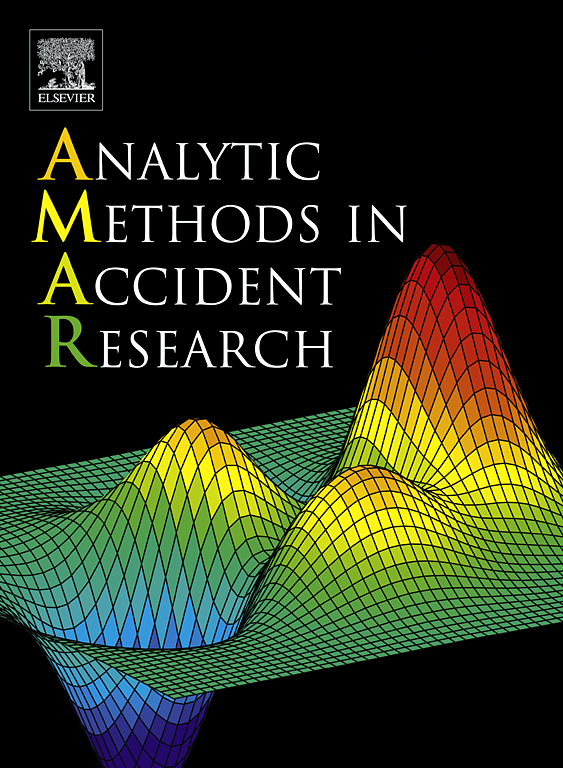Autonomous vehicle sensor data and the estimation of network-wide spatiotemporal generalized extreme value models of rear-end injury-severity crash frequencies
IF 12.6
1区 工程技术
Q1 PUBLIC, ENVIRONMENTAL & OCCUPATIONAL HEALTH
引用次数: 0
Abstract
Existing traffic conflict-based extreme value modeling applications are primarily restricted to a few concentrated locations due to the scarcity of network-wide vehicular trajectory data and the constraints associated with traditional network-wide modeling techniques. As such, this study develops a network-wide bivariate spatiotemporal non-stationarity generalized extreme value model to estimate rear-end crash frequency by injury severity level using Argo AI autonomous vehicle sensor data. Fusing this dataset with road network data from the Florida Department of Transportation, this paper studies a road network of 57 intersections and mid-blocks in Miami, Florida. Modified time-to-collision and the expected post-collision velocity difference (Delta-V) are used to estimate severe and non-severe rear-end crashes. Road geometry, road classification, and traffic state variables are used as covariates to address spatiotemporal heterogeneity in the generalized extreme value model estimation. Results show the significant impact of spatiotemporal variables such as lane width, median width, dedicated street parking, dedicated bike lane, vehicle class, and road class on rear-end crash frequency by injury severity levels. It is found that the bivariate spatiotemporal generalized extreme value model outperforms the bivariate random intercept generalized extreme value model and the univariate generalized extreme value model with conditional severity probability when benchmarked against observed annual crash frequency using root mean square error and the coefficient of determination (R-squared). Additionally, the bivariate spatiotemporal generalized extreme value model provides the closest estimate of observed severe crashes by roadway segments in the study area. The findings of this study underscore the importance of proactive network-wide safety management using spatiotemporal heterogeneity and autonomous vehicle sensor data to estimate crash frequency by severity for real-time decision-making.
自动驾驶汽车传感器数据及追尾伤害严重碰撞频率网络时空广义极值模型估计
现有的基于交通冲突的极值建模应用主要局限于几个集中的地点,这主要是由于全网络车辆轨迹数据的稀缺性和传统全网络建模技术的约束。因此,本研究利用Argo AI自动驾驶汽车传感器数据,开发了一个全网络双变量时空非平稳性广义极值模型,根据损伤严重程度估计追尾碰撞频率。本文将该数据集与佛罗里达州交通部的道路网络数据融合,研究了佛罗里达州迈阿密市由57个十字路口和中间街区组成的道路网络。修正碰撞时间和预期碰撞后速度差(Delta-V)用于估计严重和非严重追尾碰撞。在广义极值模型估计中,使用道路几何形状、道路分类和交通状态变量作为协变量来解决时空异质性问题。结果表明,车道宽度、中位宽度、专用街道停车、专用自行车道、车辆类别和道路类别等时空变量对不同伤害严重程度的追尾碰撞频率有显著影响。研究发现,当使用均方根误差和决定系数(r平方)对观测到的年碰撞频率进行基准测试时,二元时空广义极值模型优于二元随机截距广义极值模型和单变量条件严重概率广义极值模型。此外,二元时空广义极值模型提供了研究区域内按路段观察到的最接近的严重碰撞估计。这项研究的结果强调了主动的全网络安全管理的重要性,利用时空异质性和自动驾驶汽车传感器数据,根据严重程度估计碰撞频率,以进行实时决策。
本文章由计算机程序翻译,如有差异,请以英文原文为准。
求助全文
约1分钟内获得全文
求助全文
来源期刊

Analytic Methods in Accident Research
Multiple-
CiteScore
22.10
自引率
34.10%
发文量
35
审稿时长
24 days
期刊介绍:
Analytic Methods in Accident Research is a journal that publishes articles related to the development and application of advanced statistical and econometric methods in studying vehicle crashes and other accidents. The journal aims to demonstrate how these innovative approaches can provide new insights into the factors influencing the occurrence and severity of accidents, thereby offering guidance for implementing appropriate preventive measures. While the journal primarily focuses on the analytic approach, it also accepts articles covering various aspects of transportation safety (such as road, pedestrian, air, rail, and water safety), construction safety, and other areas where human behavior, machine failures, or system failures lead to property damage or bodily harm.
 求助内容:
求助内容: 应助结果提醒方式:
应助结果提醒方式:


